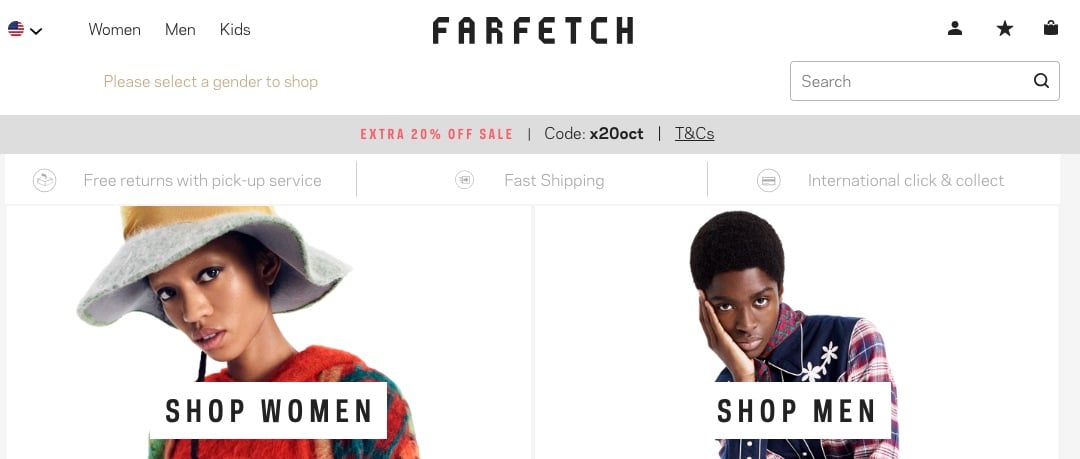
Farfetch, an online luxury-fashion marketplace, issued public shares on Sept. 21 on the New York Stock Exchange.
In one of the largest consumer-facing IPOs of the year, Farfetch, an online luxury-fashion marketplace, listed on the New York Stock Exchange on September 21. Initially priced at $20 per share, the stock — FTCH — opened at $27 per share, rose to $30 and closed at $28.20, 41 percent above the target opening price. The company, which is based in London, sold 44.2 million shares and raised $885 million in the IPO, ending with a valuation of $6.2 billion, including shares already held by employees.
Farfetch could have listed on the London Stock Exchange or the Financial Times Stock Exchange. But it chose a U.S. exchange presumably because of the financial uncertainty caused by Brexit. Another advantage is that by filing in the U.S., Farfetch can take advantage of certain disclosure benefits. It states in its F-1 registration filing (for foreign entities):
We are eligible to be treated as an emerging growth company, as defined in Section 2(a) of the Securities Act, as modified by the JOBS Act, and we may take advantage of certain exemptions from various reporting requirements that are applicable to other public companies that are not emerging growth companies, including presenting only limited selected financial data in the registration statement on Form F-1 of which this prospectus is a part and not being required to comply with the auditor attestation requirements of Section 404 of the Sarbanes-Oxley Act. As a result, our shareholders may not have access to certain information that they may deem important.
However, being located in the U.K. has some potential drawbacks. In its filing, Farfetch states:
Lack of clarity about future U.K. laws and regulations, including financial laws and regulations, tax and free trade agreements, immigration laws and employment laws, could increase costs, depress economic activity, impair our ability to attract and retain qualified personnel. There is significant uncertainty about our future ability to employ E.U. nationals. If the United Kingdom and the European Union are unable to negotiate acceptable withdrawal terms or if other European Union member states pursue withdrawal, barrier-free access between the United Kingdom and other European Union member states or among the European Economic Area overall could be diminished or eliminated. Any of these factors may have a material adverse effect on our business, results of operations, financial condition and prospects.
Farfetch is operating with a dual-class stock structure. It offered Class A shares with one vote per share, and Class B shares with 20 votes per share. Founder José Neves, 44, owns the Class B shares and, as a result, has a controlling stake in the company with 77.4 percent of voting rights.
Worldwide Customers
Founded by Portuguese billionaire Neves in 2007, Farfetch operates in Europe, the U.S., the Middle East, and the Asia Pacific. In 2017, Farfetch initiated a partnership with JD.com to sell luxury brands in Asia. However, most of its retailers and brands are based in the U.K.; they account for 86 percent of revenue.
As of June 30, 2018, the Farfetch marketplace provided access for over 2.3 million consumers in 190 countries to 980 luxury sellers. Of the 2.3 million customers, 1.1 million are considered “active consumers” — more than occasional purchasers. In 2017, 91 percent of orders were cross-border, and the top 1 percent of Farfetch’s customers accounted for approximately 20 percent of the marketplace’s gross merchandise value. The company has offices in the U.S. (Los Angeles), Brazil, Portugal, and China.
In 2015 Farfetch acquired a small brick-and-mortar British boutique called Browns.
Farfetch hosts 614 independent luxury retailers and 375 brands. In 2017, Farfetch had $386 million in sales, up 59 percent from 2016. However, losses are growing at an equally high rate. In 2017, Farfetch incurred losses of $112 million, 37 percent more than the $81 million it lost in 2016 and nearly double the 2015 losses of $61 million. Farfetch will likely exceed last year’s losses because in the first six months of 2018 it lost $68 million. The company has never been profitable.
Befitting a luxury fashion marketplace, Farfetch targets wealthy consumers. It reports that the average household income of its customers is $121,500, and 66 percent are female. The average age is 36.
How Farfetch Works
Vendors typically enter into one-year contracts with Farfetch. Ninety-eight percent of those vendors are exclusive to Farfetch.
Farfetch provides localized websites, multilingual customer support, and logistics services. This includes same-day delivery in 18 major global cities.
Farfetch operates a revenue-sharing model in which it receives commissions from merchant transactions. It does not control the pricing strategies of merchants, except for Browns, which could affect its ability to compete on price with the other distribution channels used by its brands and retailers.
Bain & Company, a financial consulting firm, estimated the global market for personal luxury goods at $307 billion in 2017 and will grow to $446 billion in 2025. Online sales comprise only 9 percent of total luxury sales, so there is a lot of potential for growth. Much of the growth is expected to come from China, but the current trade war between China and the U.S. could dampen the Chinese economy and consumer spending.